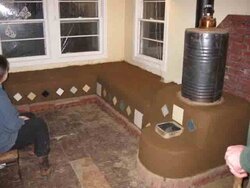churchie said:
Hi Marty, we all owe you a big thanks for patiently responding. I think there are a couple folks who have a masonry heater who find hearth and then quickly figure out they are in small company and don't hang out. Because you've had your share of stoves and understand 'the physics' of different products makes it even pertinent. .02, maybe you should make 'the basics of masonry heaters' youtube and then point folks there from time to time.
Off topic point on cost: My co-worker just bought a Cadillac CTS - something he's wanted for five years. My grandfather had a $10k 25' sailboat. A house I bike past has a ginormous masonry fireplace that has to be 15' or more tall - from my observation probably used less than 30 times per year (in the two years I've biked past it it's never been used). I just so happen to want a masonry heater a lot more than a Cadillac, sailboat, or huge patio with outside fireplace. So when I get the opportunity someday, that's what I'm doing. Maybe the kids will be grown and gone - right about the time my bones will need the extra warmth for the winter. The 'cost discussion' is all about what people consider a priority in their lives. If they want something bad enough, a lot of them do find a way to get it.
I've had that 'cost' thing tossed at me before. Believe me, it's all relative (see below previously prepared). Keep reading.
Costs (of ‘expensive’ $25K masonry heater) are relative. And, it’s for essential home heat.
SAVINGS/PAYBACK CALCULATIONS (‘Tight’ new 2900 SF main & loft home)
Nov ‘04 - Oct ‘08 (48 months)
With Masonry Heater/Harman TLC 2000
$2876. (1278 G) LPG Purchases, actual @ $2.25/G ave
(stove, H/W, Onan 12K generator)
$ 300. Cordwood Purchases
(Rotator cuff inj shoulder 3/05)
$ 250. Anthracite Purchases (basement stove)
$ 65. Chainsaw/tractor fuel
__________
$3491. /48 months = $ 73./month
Without Heater/Stove - Est Expenses
$7200. LPG ($300/mo x 48 mo/2)
$7200. LPG cost 4 years w/o add’l heaters
- 2876. LPG cost 4 years w/ add’l heaters
_______
$4324. Saved in 4 years
BUT, I burn my own wood, so
$3200. Saved from not buying most firewood
(4 cords/yr @ $200/cord x 4 years)
$1881. Average saved per year
$25K/$1881. = Payback is 13.3years (worse case) without adding up non-essential expenses or using current LPG costs (below).
For just 1 year, add up what you spend on non-essentials such as:
$25000. Your second or third vehicle (I have one)
$3000 - ? Your boat (I had three and I admit it’s a weakness, sorry)
$15000 Swimming pool for your house
$125000 Your “hunting cabin” or second home (I have one home)
$1500 Tobacco $5/pk x 300/yr (a vice that’s not nice)
$3600 Ethanol $10/day (wine, beer, booze)
$50000 - ? Your mistress (Been thar, done that - a real waste)
$2500 Eating at restaurants (I do this modestly)
$3500 Hunting and fishing trips (I quit killin’ things long ago)
$1000 Blown pocket money, ATM w/drawls (Everyone does this)
? “Stuff” you bought but haven’t used in at least a year
(It adds up)
$$Big Bucks A divorce or two (see a few lines up;no comment)
Yada, Yada, Yada
and the cost, ease, safety, effectiveness, eco-friendlyness and convenience of a big hot rock (aka masonry heater) in your home doesn’t seem so out of the question.
Other testimonials:
1. “Today, many people think nothing of spending tens of thousands of dollars for an automobile that holds its value for a very short time. But the investment in a masonry stove is truly rock solid. As part of a home remodeling project or new home construction, masonry stoves easily pay for themselves - in reduced heating costs, increased comfort, and added value to the home.”
http://www.fnaturalhomes.com/fountainheat.htm
2. "There is one other important if not vital thing to consider with all of the talk of money and payback. Marty, or anyone else with a masonry heater, is making a fractionally larger long-term payment, (added pro-rata principal and interest due to masonry heater), in return for receiving short-term benefits, such as decreased wood consumpton, a cleaner chimney, few needed replacement parts and a safe comfortable heat source which doesn’t need much tending so it’s a nice thing to have now. But if the world went to crap it would be great to have since you can get heat, cooking, and hot water with few moving parts. So it’s not only an investment, it’s also a hedge against risk.
A payment in return for decreased risk and more certainty with regard to return on investment is called insurance And if one takes a look at it that way then these look even better as ‘investments’."
--Commercial Real Estate Insurance Person
Aye,
Marty




 ) masonry heater setups I've ever seen. many of them have fairly large write-ups and galleries on their construction and use.
) masonry heater setups I've ever seen. many of them have fairly large write-ups and galleries on their construction and use.